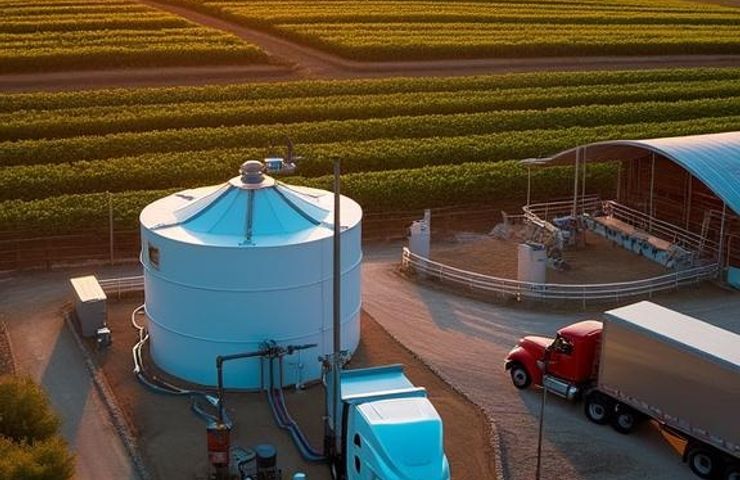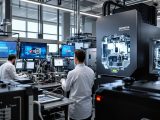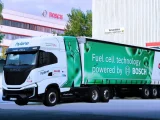
Hydrogen Production from Dairy Biogas: Utility Global and Maas Energy Works Launch Carbon-Negative Project in California
October 14, 2025Guess what? California’s dairy fields are about to take center stage in hydrogen production. On October 7, 2025, Utility Global and Maas Energy Works announced they’re teaming up to turn everyday manure biogas into carbon-negative hydrogen fuel. Their pilot plant, nestled in a California dairy complex, should be up and running by early 2026. When it goes live, it’ll pump out around three tons of H2 a day—perfect for powering heavy-duty trucks and pushing the envelope on zero-emission technology.
Key Takeaways
- This partnership leans on H2Gen, Utility Global’s biogas-to-hydrogen system that skips the grid entirely.
- Once stable, it’s set to produce about three tons per day of deeply carbon-negative hydrogen.
- It dovetails neatly with California’s push to decarbonize heavy-duty fleets and cut smog-causing pollutants.
- It lays groundwork for expanding hydrogen infrastructure while bolstering U.S. energy independence.
- Independent audits rank it among the lowest carbon-intensity hydrogen fuels out there.
- Its modular design can be cloned across other dairy farms and industrial sites.
Dairy Biogas Meets H2Gen
The real secret sauce is H2Gen. Rather than using an electrolyzer and calling it green hydrogen, H2Gen reformulates methane from biogas with water, yielding hydrogen and recycled CO₂. Since that CO₂ originally came from manure, there’s no fresh carbon footprint—hence the “carbon-negative” label. Plus, it runs off-site without any grid power, dodging the upstream emissions you usually see in renewable hydrogen production. Typical farm biogas is a messy mix—about 55% methane plus CO₂, moisture and a few rogue gases—but H2Gen handles it straight out of the digester. No pricey cleanup needed, which keeps operations lean and predictable.
Market Forces and Partnerships
Maas Energy Works already has a track record in California’s Central Valley, building dairy digesters that turn cow manure into biogas for power. Now they’re joining forces with Utility Global, whose plug-and-play H2Gen reactors bring the hydrogen chops. By pooling know-how, they’re shaving down technical risks and speeding up the timeline. On the revenue front, they’re setting up offtake deals with fueling stations and fleet operators to guarantee a steady stream of buyers. Utility Global is offering the H2Gen units on a lease model, so dairy owners dodge big capital outlays and only pay for performance. Bonus: the waste heat from the reforming process can be recycled into farm operations—think heating digester tanks—bumping up overall efficiency. With LCFS credits and federal Inflation Reduction Act tax breaks, they expect hydrogen to compete dollar-for-dollar with low-carbon diesel on a per-mile basis.
California’s Climate Playbook
Choosing California wasn’t random. The state demands a 40% cut in greenhouse gas emissions from 1990 levels by 2030 and is eyeing carbon neutrality by 2045. Under the Low Carbon Fuel Standard, fuels with negative carbon intensity snag top-dollar credits—usually between $200 and $300 for every ton of CO₂ avoided—covering a chunk of operating costs. The U.S. Department of Energy has also flagged six regional hydrogen hubs; the Central Valley is front and center. DOE grants for these hubs could funnel extra dollars into this project and others like it. And with California’s Air Resources Board tightening NOx limits on heavy-duty trucks, fleet operators are itching for cleaner options.
Strategic Implications
Tackling heavy-haul emissions is no small feat. Diesel rigs dominate long-haul routes because batteries lack range and take forever to recharge. Fuel cell technology powered by carbon-negative hydrogen could be the missing link, offering quick fill-ups and enough juice for regional runs. By anchoring a local hydrogen production hub, this pilot jumpstarts new hydrogen infrastructure along key corridors—from Los Angeles to Sacramento—paving the way for a broader shift toward zero-emission technology in transport.
Looking Ahead
If the pilot works as planned, both companies aim to replicate it at dairies across California. There are thousands of those farms, each with the potential to feed biogas into a similar setup. Nearby states show promise, too. Down the line, they’re envisioning clusters of digesters and H2Gen reactors cranking out 10 tons of H2 per day. And it’s not just dairies—landfill gas, wastewater sludge and other organic waste streams could jump-start more industrial decarbonization projects.
Ramping Up Amid Challenges
Sure, it’s not all smooth sailing. Permitting biogas plants can be a maze—local odor rules and nuisance complaints are real hurdles. Dropping big capital in rural areas, tying into distribution networks, and locking down offtake agreements take time. Plus, turning cow poop into fuel might raise a few eyebrows; transparent outreach will be key. Still, with supportive policies, rising demand from fleets, and federal grants aimed at clean hydrogen hubs, we could see dozens more bio-hydrogen sites by 2027.
At its core, this is more than just swapping diesel for hydrogen. It’s a living blueprint for tapping underused waste streams and proving that sometimes, the simplest path to decarbonization is right under our cows’ feet.
About the Companies
Utility Global, Inc. is an American innovator in cost-effective decarbonization. Its H2Gen process turns biogas into hydrogen without electric power, achieving some of the lowest carbon intensities in the industry.
Maas Energy Works specializes in dairy digester-to-energy projects, converting manure into biogas and clean electricity. They’ve rolled out multiple systems across California’s Central Valley to support sustainable farming and renewables.



 With over 15 years of reporting hydrogen news, we are your premier source for the latest updates and insights in hydrogen and renewable energy.
With over 15 years of reporting hydrogen news, we are your premier source for the latest updates and insights in hydrogen and renewable energy.